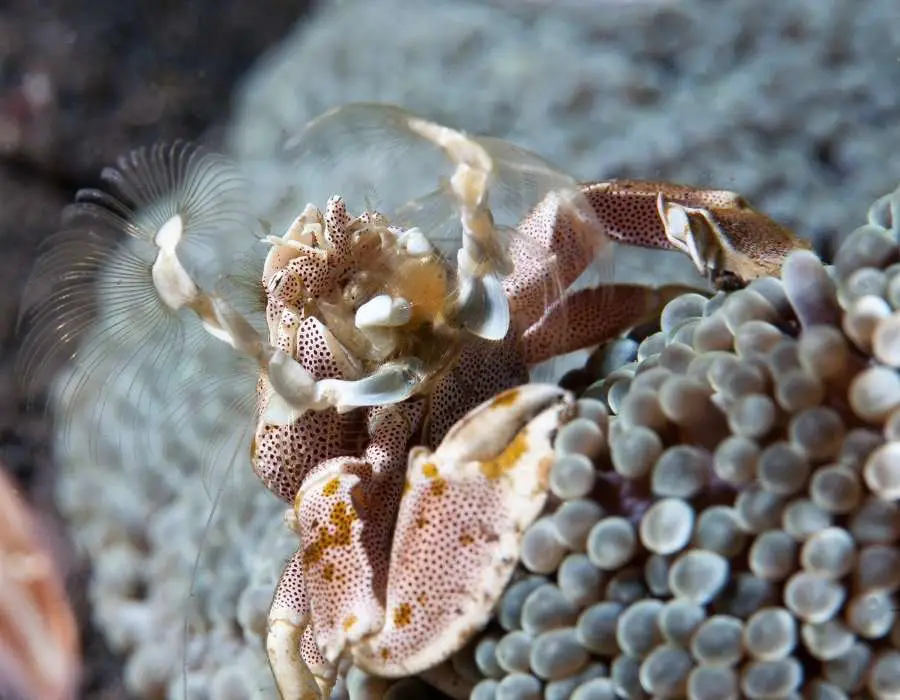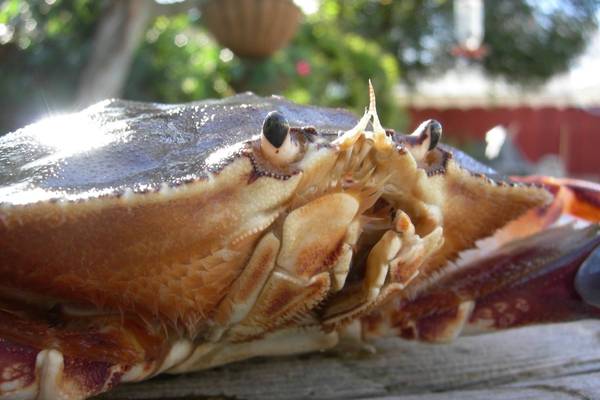Crab mouths can handle a wide variety of food types and a wide variety of foraging strategies, from filter feeding to actively catching prey. Most crabs are also capable of feeding both on land and in the water.
While the mouth parts of some crab species are slightly modified to fit their preferred food types and foraging strategies, the basic structure of the mouth parts of all crab species is essentially the same. Instead of having two jaws with teeth like us, crabs have 12 mouth parts and no teeth.
The lack of teeth means that they cannot chew their food. Crabs also cannot breathe through their mouth, but they do sometimes blow bubbles.
With mouths that look and work very differently from ours, crabs are well adapted to their opportunistic feeding style both on land and in the water.
Contents
Crab Mouth Anatomy
The mouth of a crab is made up of different parts with different functions. A crab’s mouth is made up of one pair of mandibles, two pairs of maxillae, and three pairs of maxillipeds1. The mandibles or jaws are heavy, triangular structures used to crush larger food parts.
The maxilla are slimmer structures that assist the jaws in manipulating and breaking up food particles. The maxillipeds are modified legs that are used to move food particles into the mouth.
The exact shape and function of these parts depend on the species and diet of the crab.
For example, porcelain crabs, who are filter feeders, have hair-like structures on their third maxilliped, which form a fan-like structure.

They will hold out these fans in the current to catch small food particles suspended in the water.2
In contrast, carnivorous crabs, like the giant crab, have short, stiff hairs on their maxillipeds that help them to grip food while their pincers rip them to pieces.
Their mandibles are non-symmetrical and beak-like. The right mandible is larger and overlaps the left mandible. This structure allows them to crush large food items.3
However, in general, the mouth of most crabs works like this:
- The first stage of the feeding process after the food has been torn apart by the large pinchers is when the maxillipeds are used.
- The maxillipeds are the first three leg-like antennae near the mouth of the crab. They become more leg-like and closer to the body of the crab.
- The third maxillipeds are used mostly for grooming but also for feeding where they are holding large pieces of food so that pieces can be torn off by the mandibles and ingested.
- The next stage in how the mouth of crabs work is that small food particles are passed toward the mouth by a small pincher.
- The second maxilliped opens to receive it into the first part of the mouth and then remains closed until the food is ingested. The inner mouthparts act like a ratchet, moving the food to the mouth, where it is broken up by the jaws if required.
- The last stage in how crabs’ mouths work is when posterior mouthparts assist in scraping food off the jaw outer parts and also sort and reject sand grains and other inedible matter so that it does not get swallowed into the stomach of the crab!
Do crabs have teeth in their mouth?
The simple answer is no, crabs do not have teeth in their mouth like humans or many other animals. Instead of the conventional teeth, crabs have specialized mouthparts that function differently.
As mentioned earlier, crabs possess a variety of mouthparts that help them handle and process food.

The primary mouthparts involved in the physical breakdown of food are the mandibles or jaws. These mandibles are robust, triangular structures that can crush larger food parts. However, these are not teeth in the traditional sense and cannot be used for chewing.
Instead, the various mouthparts work in tandem to manipulate, break down, and ingest food. The maxillae, which are slimmer, assist the mandibles in manipulating and fragmenting food particles. On the other hand, the maxillipeds, which are modified legs, help in moving the food particles towards the mouth.
In the absence of teeth, crabs have evolved to use these specialized structures efficiently to feed on a wide range of diets, from filter-feeding to preying on larger animals. The absence of teeth doesn’t hinder their eating capability but rather showcases their unique evolutionary adaptation to their environment and feeding habits.
So, while crabs don’t have traditional teeth to chew their food, their diverse and specialized mouthparts ensure they are well-equipped to handle the foods they encounter in their environments.
How do crabs chew their food?
While their mouthparts can break food particles into small enough pieces to swallow, the pieces need to be broken down further before they can be digested. To do this, they have teeth in their stomach – like seahorses do!
This structure is called a gastric mill and can be found in all crustaceans, including crabs, crayfish, lobsters, and barnacles, but also in the insects that crustaceans are related to.
The gastric mill is made up of hard, teeth-like structures and strong muscles folded into ridges5.

Together, these structures are used to grind food before it travels further into the digestive system.
In addition to grinding food, the ghost crab can use their gastric mill to produce a threatening sound during aggressive interactions6. Luckily, all crustaceans including lobsters, crayfish, and crabs can regrow their limbs if they are lost in a fight!
Do crabs breathe through their mouth?
Crabs do not breathe through their mouth. Most crabs breathe with their gills, which are attached to the base of each of their legs.
While some crabs are better adapted to living on land and others are more aquatic, most crabs can breathe both on land and in water to some extent. The same is the case for lobsters and crayfish.
Water or air enters their gill chambers from openings in their shell at the base of their legs and leaves through openings near their mouth.
While they do not use their mouths to breathe, some of their mouthparts are involved in respiration.
For example, the bailer on the second maxilla is a paddle-like structure that moves water or air over the gills to assist in breathing.
The second and third maxillipeds have gills attached to their base, similar to the walking legs.
Why do crabs sometimes froth at their mouths?
On land, crabs sometimes produce bubbles when they breathe. This is because crabs breathe in through openings at the base of their legs and breathe out through openings by their mouth.
While on land, crabs store water in their gill chambers to keep their gills moist and functioning.
Similar to humans, crabs produce CO2 as a waste product of respiration. Their blood carries the CO2 to their gills, where the COs is dumped, and fresh oxygen is absorbed to carry to the rest of the body.
The released CO2 produces bubbles as they move through the water in the gill chambers. These bubbles come out through the openings near their mouth, covering the crab’s mouth in foam.
What is the mouth of crabs, lobsters, and crayfish called?
The outer mouthparts of all crustaceans are scientifically referred to as “maxillipeds”, which are the moving parts of the mouth that brings in food.
Maxillipeds resemble (and likely evolved from) pairs of legs on a crab that are modified for chewing and grasping. They are located just behind the mouthparts and may be seen as a kind of tongue for crustaceans!
The inner mouthparts do not really have a common name, but consist of many different structures.
Where is a hermit crab’s mouth?
Like other crab species, the mouth of the hermit crab sits in the front. It is located in between the eyes and claws at the very front.

Their mouth is located on the bottom side of their head, just behind where their claws attach. This positioning allows them to feed and move relatively safely inside their shell.
Are all crab species mouths in the same location?
The mouthparts of all crab species are located in the same basic area on their body. The mandibles are located in the center of the mouth, and the maxillae and maxillipeds are located on either side. However, the specific location varies slightly between species.
For example, in fiddler crabs, the mandibles are located at the very front of their head, while in hermit crabs, they are located a bit further back. This difference is due to their different diets and foraging strategies.
Fiddler crabs use their large claws to actively capture prey items. Their mandibles need to be close to their claws so they can quickly grab and crush prey items before they have a chance to escape.
Crabs, like hermit crabs, are not as active predators and mostly scavenge for food that has already been killed. They do not need their mandibles to be as close to their claws and can afford to have them further back in their mouthparts.
How many mouths does a crab have?
Crabs only have one mouth as is the case for most other animals as well, but they have two mandibles.
Crabs have two mandibles, one on either side of their mouth, which they use to crush and break apart their food.
They also have several pairs of maxillae, which are smaller mouthparts that help manipulate and move food into the mandibles.
Conclusion
If you read the article a bit fast and want to take home the most important facts about the mouths of crabs, here they are:
- The mouthparts of a crab are adapted to the crab’s diet and foraging strategies, whether it is filter feeding, actively catching prey, or scavenging.
- Crabs lack teeth but make up for it with a gastric mill in their stomach that helps them to grind food before it travels further into the digestive system.
- Crabs also do not breathe through their mouth, but they do sometimes froth at their mouths due to the release of CO2 bubbles.
I hope you found this article informative and if you want to know more about crabs, lobsters, and crayfish, take a look around my site (use the search function!).
References
- Hickman CP, Kats LB. 2006. Laboratory studies in integrated principles of zoology (13th ed.). McGraw-Hill.
- Achituv Y, Pedrotti ML. 1999. Costs and gains of pecelain crab suspension feeding in different flow conditions. Marine ecology progress series. 184: 161 – 169. https://www.int-res.com/articles/meps/184/m184p161.pdf
- Heeren T, Mitchell BD. 1997. Morphology of the mouthparts, gastric mill and digestive tract of the giant crab, Pseudocarcinus gigas (Milne Edwards) (Decapoda:Oziidae). Marine and Freshwater Research. 48:7–18. https://doi.org/10.1071/MF96026
- O’Mahoney PM, Full RJ. 1984. Respiration of crabs in air and water. Comparative Biochemistry and Physiology. 79(2): 275-282.
- The Infinite Spider. 2014. Gastric Mills: Teeth in the Stomach https://infinitespider.com/gastric-mills-teeth-stomach/
- Taylor JRA, De Vries MS, Elias DO. 2019. Growling from the gut: co-option of the gastric mill for acoustic communication in ghost crabs. Proceedings of the Royal Society B. 286(1910): 20191161. https://doi.org/10.1098/rspb.2019.1161





